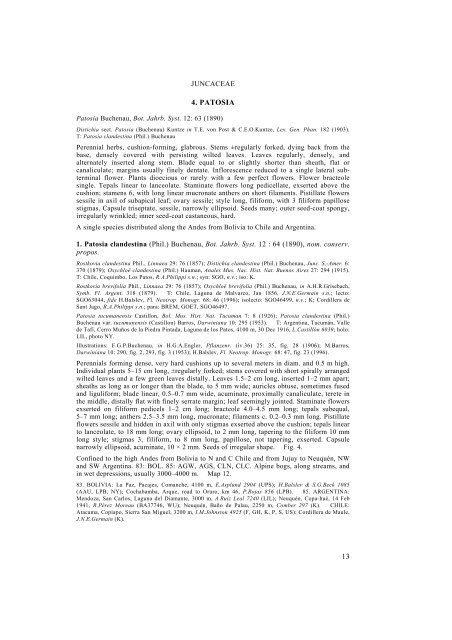Part 6. JUNCACEAE 1: Rostkovia to Luzula - Species Plantarum ...
Part 6. JUNCACEAE 1: Rostkovia to Luzula - Species Plantarum ...
Part 6. JUNCACEAE 1: Rostkovia to Luzula - Species Plantarum ...
Create successful ePaper yourself
Turn your PDF publications into a flip-book with our unique Google optimized e-Paper software.
<strong>JUNCACEAE</strong><br />
4. PATOSIA<br />
Pa<strong>to</strong>sia Buchenau, Bot. Jahrb. Syst. 12: 63 (1890)<br />
Distichia sect. Pa<strong>to</strong>sia (Buchenau) Kuntze in T.E. von Post & C.E.O.Kuntze, Lex. Gen. Phan. 182 (1903).<br />
T: Pa<strong>to</strong>sia clandestina (Phil.) Buchenau<br />
Perennial herbs, cushion-forming, glabrous. Stems ±regularly forked, dying back from the<br />
base, densely covered with persisting wilted leaves. Leaves regularly, densely, and<br />
alternately inserted along stem. Blade equal <strong>to</strong> or slightly shorter than sheath, flat or<br />
canaliculate; margins usually finely dentate. Inflorescence reduced <strong>to</strong> a single lateral subterminal<br />
flower. Plants dioecious or rarely with a few perfect flowers. Flower bracteole<br />
single. Tepals linear <strong>to</strong> lanceolate. Staminate flowers long pedicellate, exserted above the<br />
cushion; stamens 6, with long linear mucronate anthers on short filaments. Pistillate flowers<br />
sessile in axil of subapical leaf; ovary sessile; style long, filiform, with 3 filiform papillose<br />
stigmas. Capsule triseptate, sessile, narrowly ellipsoid. Seeds many; outer seed-coat spongy,<br />
irregularly wrinkled; inner seed-coat castaneous, hard.<br />
A single species distributed along the Andes from Bolivia <strong>to</strong> Chile and Argentina.<br />
1. Pa<strong>to</strong>sia clandestina (Phil.) Buchenau, Bot. Jahrb. Syst. 12 : 64 (1890), nom. conserv.<br />
propos.<br />
<strong>Rostkovia</strong> clandestina Phil., Linnaea 29: 76 (1857); Distichia clandestina (Phil.) Buchenau, Junc. S.-Amer. 6:<br />
370 (1879); Oxychloë clandestina (Phil.) Hauman, Anales Mus. Nac. Hist. Nat. Buenos Aires 27: 294 (1915).<br />
T: Chile, Coquimbo, Los Pa<strong>to</strong>s, R.A.Philippi s.n.; syn: SGO, n.v.; iso: K.<br />
<strong>Rostkovia</strong> brevifolia Phil., Linnaea 29: 76 (1857); Oxychloë brevifolia (Phil.) Buchenau, in A.H.R.Grisebach,<br />
Symb. Fl. Argent. 318 (1879). T: Chile, Laguna de Malvarco, Jan 1856, J.N.E.Germain s.n.; lec<strong>to</strong>:<br />
SGO63044, fide H.Balslev, Fl. Neotrop. Monogr. 68: 46 (1996); isolec<strong>to</strong>: SGO46499, n.v.; K; Cordillera de<br />
Sant Jago, R.A.Philippi s.n.; para: BREM, GOET, SGO46497.<br />
Pa<strong>to</strong>sia tucumanensis Castillon, Bol. Mus. Hist. Nat. Tucuman 7: 8 (1926); Pa<strong>to</strong>sia clandestina (Phil.)<br />
Buchenau var. tucumanensis (Castillon) Barros, Darwiniana 10: 295 (1953). T: Argentina, Tucumán, Valle<br />
de Tafí, Cerro Muños de la Piedra Pintada, Laguna de los Pa<strong>to</strong>s, 4100 m, 30 Dec 1916, L.Castillón 6039; holo:<br />
LIL, pho<strong>to</strong> NY.<br />
Illustrations: F.G.P.Buchenau, in H.G.A.Engler, Pflanzenr. (iv.36) 25: 35, fig. 28 (1906); M.Barros,<br />
Darwiniana 10: 290, fig. 2, 293, fig. 3 (1953); H.Balslev, Fl. Neotrop. Monogr. 68: 47, fig. 23 (1996).<br />
Perennials forming dense, very hard cushions up <strong>to</strong> several meters in diam. and 0.5 m high.<br />
Individual plants 5–15 cm long, ±regularly forked; stems covered with short spirally arranged<br />
wilted leaves and a few green leaves distally. Leaves 1.5–2 cm long, inserted 1–2 mm apart;<br />
sheaths as long as or longer than the blade, <strong>to</strong> 5 mm wide; auricles obtuse, sometimes fused<br />
and liguliform; blade linear, 0.5–0.7 mm wide, acuminate, proximally canaliculate, terete in<br />
the middle, distally flat with finely serrate margin; leaf seemingly jointed. Staminate flowers<br />
exserted on filiform pedicels 1–2 cm long; bracteole 4.0–4.5 mm long; tepals subequal,<br />
5–7 mm long; anthers 2.5–3.5 mm long, mucronate; filaments c. 0.2–0.3 mm long. Pistillate<br />
flowers sessile and hidden in axil with only stigmas exserted above the cushion; tepals linear<br />
<strong>to</strong> lanceolate, <strong>to</strong> 18 mm long; ovary ellipsoid, <strong>to</strong> 2 mm long, tapering <strong>to</strong> the filiform 10 mm<br />
long style; stigmas 3, filiform, <strong>to</strong> 8 mm long, papillose, not tapering, exserted. Capsule<br />
narrowly ellipsoid, acuminate, 10 × 2 mm. Seeds of irregular shape. Fig. 4.<br />
Confined <strong>to</strong> the high Andes from Bolivia <strong>to</strong> N and C Chile and from Jujuy <strong>to</strong> Neuquén, NW<br />
and SW Argentina. 83: BOL. 85: AGW, AGS, CLN, CLC. Alpine bogs, along streams, and<br />
in wet depressions, usually 3000–4000 m. Map 12.<br />
83. BOLIVIA: La Paz, Pacajes, Comanche, 4100 m, E.Asplund 2904 (UPS); H.Balslev & S.G.Beck 1085<br />
(AAU, LPB, NY); Cochabamba, Arque, road <strong>to</strong> Oruro, km 46, P.Rojas 856 (LPB). 85. ARGENTINA:<br />
Mendoza, San Carlos, Laguna del Diamante, 3000 m, A.Ruíz Leal 7240 (LIL); Neuquén, Copa-hué, 14 Feb<br />
1941, R.Pérez Moreau (BA37746, WU); Neuquén, Baño de Palau, 2250 m, Comber 297 (K). CHILE:<br />
Atacama, Copiapo, Sierra San Miguel, 3200 m, I.M.Johns<strong>to</strong>n 4925 (F, GH, K, P, S, US); Cordillera de Maule,<br />
J.N.E.Germain (K).<br />
13












